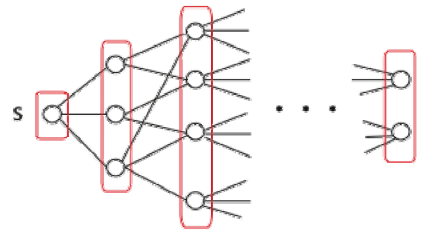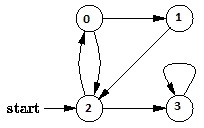广度优先搜索(BFS:Breadth-First Search)是一种图搜索策略,其将搜索限制到 2 种操作:
- (a) 访问图中的一个节点;
- (b) 访问该节点的邻居节点;
广度优先搜索(BFS)由 Edward F. Moore 在 1950 年发表,起初被用于在迷宫中寻找最短路径。在 Prim 最小生成树算法和 Dijkstra 单源最短路径算法中,都采用了与广度优先搜索类似的思想。
对图的广度优先搜索与对树(Tree)的广度优先遍历(Breadth First Traversal)是类似的,区别在于图中可能存在环,所以可能会遍历到已经遍历的节点。BFD 算法首先会发现和源顶点 s 距离边数为 k 的所有顶点,然后才会发现和 s 距离边数为 k+1 的其他顶点。

例如,下面的图中,从顶点 2 开始遍历,当遍历到顶点 0 时,邻接的顶点为 1 和 2,而顶点 2 已经遍历过,如果不做标记,遍历过程将陷入死循环。所以,在 BFS 的算法实现中需要对顶点是否访问过做标记。

上图的 BFS 遍历结果为 [ 2, 0, 3, 1 ]。
BFS 算法的实现通常使用队列(Queue)数据结构来存储遍历图中节点的中间状态,过程如下:
- 将 root 节点 Enqueue;
- Dequeue 一个节点,并检查该节点:
- 如果该节点就是要找的目标节点,则结束遍历,返回结果 "Found";
- 否则,Enqueue 所有直接后继子节点(如果节点未被访问过);
- 如果 Queue 为空,并且图中的所有节点都被检查过,仍未找到目标节点,则结束搜索,返回结果 "Not Found";
- 如果 Queue 不为空,重复步骤 2;
如果需要记录搜索的轨迹,可以为顶点着色。起初所有顶点为白色,随着搜索的进行变为灰色,然后变成黑色。灰色和黑色顶点都是已发现的顶点。
BFS 算法伪码如下:
1 procedure BFS(G,v) is 2 create a queue Q 3 create a set V 4 add v to V 5 enqueue v onto Q 6 while Q is not empty loop 7 t = Q.dequeue() 8 if t is what we are looking for then 9 return t 10 end if 11 for all edges e in G.adjacentEdges(t) loop 12 u = G.adjacentVertex(t,e) 13 if u is not in V then 14 add u to V 15 enqueue u onto Q 16 end if 17 end loop 18 end loop 19 return none 20 end BFS
广度优先搜索(BFS)的时间复杂度为 O(V+E),V 即 Vertex 顶点数量,E 即 Edge 边数量。
BFS 算法实现代码如下:
1 using System; 2 using System.Collections.Generic; 3 4 namespace GraphAlgorithmTesting 5 { 6 class Program 7 { 8 static void Main(string[] args) 9 { 10 Graph g = new Graph(4); 11 g.AddEdge(0, 1); 12 g.AddEdge(0, 2); 13 g.AddEdge(1, 2); 14 g.AddEdge(2, 0); 15 g.AddEdge(2, 3); 16 g.AddEdge(3, 3); 17 18 List<int> traversal = g.BFS(2); 19 foreach (var vertex in traversal) 20 { 21 Console.WriteLine(vertex); 22 } 23 24 Console.ReadKey(); 25 } 26 27 class Edge 28 { 29 public Edge(int begin, int end) 30 { 31 this.Begin = begin; 32 this.End = end; 33 } 34 35 public int Begin { get; private set; } 36 public int End { get; private set; } 37 } 38 39 class Graph 40 { 41 private Dictionary<int, List<Edge>> _adjacentEdges 42 = new Dictionary<int, List<Edge>>(); 43 44 public Graph(int vertexCount) 45 { 46 this.VertexCount = vertexCount; 47 } 48 49 public int VertexCount { get; private set; } 50 51 public void AddEdge(int begin, int end) 52 { 53 if (!_adjacentEdges.ContainsKey(begin)) 54 { 55 var edges = new List<Edge>(); 56 _adjacentEdges.Add(begin, edges); 57 } 58 59 _adjacentEdges[begin].Add(new Edge(begin, end)); 60 } 61 62 public List<int> BFS(int start) 63 { 64 List<int> traversal = new List<int>(); 65 int current = start; 66 67 // mark all the vertices as not visited 68 bool[] visited = new bool[VertexCount]; 69 for (int i = 0; i < VertexCount; i++) 70 { 71 visited[i] = false; 72 } 73 74 // create a queue for BFS 75 Queue<int> queue = new Queue<int>(); 76 77 // mark the current node as visited and enqueue it 78 visited[current] = true; 79 queue.Enqueue(current); 80 81 while (queue.Count > 0) 82 { 83 current = queue.Dequeue(); 84 85 // if this is what we are looking for 86 traversal.Add(current); 87 88 // get all adjacent vertices of the dequeued vertex, 89 // if a adjacent has not been visited, 90 // then mark it visited and enqueue it 91 if (_adjacentEdges.ContainsKey(current)) 92 { 93 foreach (var edge in _adjacentEdges[current]) 94 { 95 if (!visited[edge.End]) 96 { 97 visited[edge.End] = true; 98 queue.Enqueue(edge.End); 99 } 100 } 101 } 102 } 103 104 return traversal; 105 } 106 } 107 } 108 }
参考资料
- 广度优先搜索
- 深度优先搜索
- Breadth First Traversal for a Graph
- Depth First Traversal for a Graph
- Introduction to Algorithms 6.006 - Lecture 13
本篇文章《广度优先搜索》由 Dennis Gao 发表自博客园,未经作者本人同意禁止任何形式的转载,任何自动或人为的爬虫转载行为均为耍流氓。